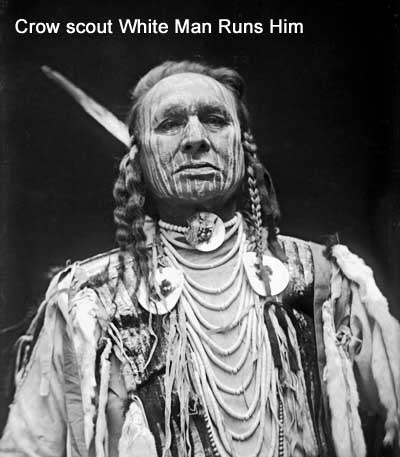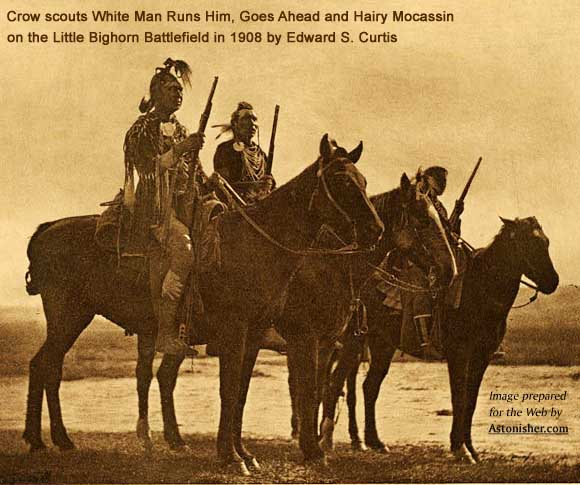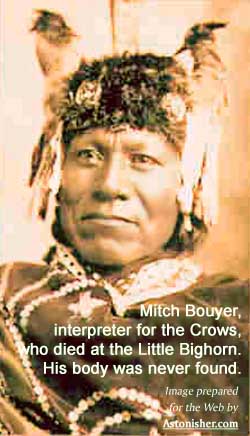|
|||||||
Bruce Brown's 100 Voices... White Man Runs Him's
The scouts with General Custer were all Crows and Arikaras. Mitch Boyer[Bouyer] a half-breed Sioux, was Chief of Scouts. The Crow Scouts were Half Yellow Face, White Swan, Goes Ahead, Hairy Moccasin, Curley and I, White Man Runs Him. On June 24th we were camped just below Busby, and Hairy Moccasin, Goes Ahead and I took some soldiers' horses and rode to a high point on the Divide between the Rosebud and the Little Horn. This place was used by the Crows as a look-out during campaigns, and from it you could see for miles around. In this hill was a pocket where horses could be hidden. We knew the trail and the way the Sioux were moving, but were not sure which way they went. When we reached the Crow look-out the light was not good and we could not see much, so we returned to camp and reported. Just after sun-down Mitch Boyer and an army officer with a long mustache and large nose [Captain Varnum] left the camp with me and started back for the look-out. I know this country well, so I acted as guide. We followed down the Lodge Pole trail, which was the regular trail from the Rosebud across to the Little Horn, and reached the look-out about two o'clock in the morning. Our horses were led into the pocket where they were hidden, and we lay down to wait for daylight. As soon as it became light enough to see, we could make out smoke from the Sioux camp down in the Little Horn Valley and could see some white horses on the other side of the Little Horn River. We also saw two Sioux about one mile and a half west moving down Davis Creek toward the soldiers' camp and six other Sioux to the northeast over on Tullock Fork. [Note: He Dog said that a Sioux named Fast Horn was one of the Indians they saw that morning. Standing Bear said he was in the pary that spotted Varnum too.] The soldiers had marched during the night and were now camped a little below us on Davis Creek. We could see the smoke of their camp-fires as they cooked breakfast. In a little while we saw the soldiers marching up Davis Creek, and Custer stopped opposite to our look-out. I went down and told him about the smoke we had seen from the Sioux camp. This was about six o'clock in the morning. Custer came up the hill far enough to see over and down the valley. When he saw the Sioux village, he said: "These people are very troublesome and bother the Crows and white people. I am going to teach them a lesson today. I will whip them and will build a fort at the junction where the Little Horn flows into the Bighorn, and you Crows may then live in peace." He said he would finish the Sioux trouble. We scouts thought there were too many Indians for Custer to fight. There were camps and camps and camps. One big camp was in a circle near the west hills. I would say there were between four thousand and five thousand warriors, maybe more, I do not know. It was the biggest Indian camp I have ever seen. If we had not seen the two Sioux scouts earlier in the morning, I would have advised Custer to hide at this point all day, and then surprise the camp at night, but since these scouts had seen the soldiers it was no use to wait longer. I was one of the oldest of the scouts and did most of the advance scouting. I knew this country very well, so I told Custer he had better go down Ash Creek (Reno Creek), then he could wait this side of the Divide before going into the Little Horn Valley. Custer moved forward, the soldiers going at a fast trot down Ash Creek. Our ponies were much smaller than the horses ridden by the soldiers, so we had to gallop most of the time to keep up. Custer followed down the Lodge Pole Trail, which goes down the North Fork of Upper Ash Creek. This trail comes from the Rosebud up Davis Creek through a pass to the North Fork of Upper Ash Creek, then down Ash Creek to the Little Horn River and is fairly smooth. About nine miles down the Upper Fork of Ash Creek, we found a lodge with a dead Indian inside. He had probably died from wounds received in the battle with General Crook on the Rosebud June 17th. [Note: According to Feather Earring, White Man Runs Him was correct; the dead Sioux warrior was named Old She Bear.] As we passed by, some soldiers set fire to this lodge.
Custer halted his command on a small flat about a mile and a quarter from the mouth of Ash Creek, and ordered Major Reno to swing out to the left, cross the Little Horn and attack the upper end of the Sioux village. He saw some dust rising near the mouth of the Creek and called Half Yellow Face, the leader of the Crows, to him and asked what the dust was. Half Yellow Face said: "The Sioux must be running away." [Note: this echoes what Fred Gerard also told Custer, and what Fred Goldin heard Custer say to Keogh.] But Custer said: "I will throw my left wing [Reno] south in case the Sioux should go that way." Then Reno moved out and crossed the Creek just below the flat. Custer then called White Swan and told him and Half Yellow Face to go over to the ridge and see what was going on in the Sioux camp. They started, but instead of going over to the ridge as they were told, they followed Reno, and that was the last we saw of them until the trouble was over. Then Custer started moving toward the ridge. Mitch Boyer (Chief of Scouts) noticed the scouts whom Custer had sent to look over the ridge, had followed Reno, so he called Curley, Goes Ahead, Hairy Moccasin and me and said: "Let us go over to the ridge and look at the lodges." When we reached there, we saw that the lodges were over in the valley quite a ways down the river, so we moved on ahead, Custer following. This was about nine o'clock in the morning. Custer moved slowly, taking lots of time and stopping occasionally. He did not leave that place until Reno had started fighting. Before Reno left Custer on the flat, another body of soldiers had been ordered away towards the left, but we were far in advance at that time, so I do not know where they went (This was Captain Benteen). Custer and his brother went to the right of us and halted on a small hill. His troops were moving forward below him. Custer turned around as he reached the top of the hill and waved his hat, and the soldiers at the bottom of the hill waved their hats and shouted. Custer then proceeded on up the ridge and his men followed. [Note: Fred Goldin also described Custer grandly waving is hat to his men below. Medal of Honor winner Stan Roy was one of the men with Reno who saw Custer on the bluff.] They were moving rapidly, and the scouts were forced to gallop their ponies sometimes to keep up with them. At a certain point on the ridge they turned to the right and rode down a coulee in a northern direction.
After sun-down that night I slipped through the Indian line and swung around towards the north, and the next morning at day-break I was down where the Little Horn flows into the Bighorn River. There were some soldiers there (General Terry's) and their leader was an officer whom the Indians called "Man Without Hip" or "Lame Hip" (General Terry) and another officer whom the Indians called "White Whiskers" (General Gibbon). I told them all I knew about the fight, and that my clothes were worn out. I had no moccasins, so I was going home. The officers said all right and I rode on. I went to Pryor where the Crows were camped. When I came into camp, some of the Crows thought I was a Sioux and commenced shooting at me. I have heard many people say that Curley was the only survivor of this battle, but Curley was not in the battle. Just about the time Reno attacked the village, Curley with some Arikara scouts ran off a big band of Sioux ponies and rode away with them. Some of the Arikaras, whom I met afterwards, told me that Curley went with them as far as the Junction (where the Rosebud joins the Yellowstone River). I did not see Curley again until the next fall, when I met him up on the Yellowstone in the camp of the Mountain Crows, so Curley did not see much of the battle. I cannot remember every detail of the fight because there were so many things happening during the day and so much excitement that it is hard to remember little things, but I have tried to give a general outline of the campaign, and have told only the things that I saw. I remember Custer well. The Indians called him the "Son of the Morning Star." He had long yellow hair, and at the time of the battle was dressed entirely in buckskin. If it were not for Mitch Boyer, who sent us back, Hairy Moccasin, Goes Ahead; and I too would be buried over on that ridge with Custer and his men. I have told you only the truth without trying to claim any credit myself, and Curley, who was with us, cannot deny the truth of my story. The Custer Myth: A Source Book of Custerania, written and compiled by Colonel W.A. Graham, The Stackpole Co., Harrisburg, PA 1953, p 20 - 24
This eye-witness account of the Battle of the Little Bighorn by White Man Runs Him, who was one of the four Crow scouts who rode with Custer down Medicine Tail Coulee just before Custer was killed, is important because it establishes that Custer tried to charge across the Little Bighorn to attack the Indian village at the very beginning of the Custer fight. White Man Runs Him said, "Custer tried to cross the river at the mouth of Medicine Tail Creek, but was unable to do so. This was the last we saw Custer." White Man Runs Him later added, "I know for sure that Custer went right to the river bank. I saw him go that far. The Sioux were right across the river." When Custer led the Seventh Cavalry's charge across the Little Bighorn to attack the Indian village moments later, Oglala Sioux warrior White Cow Bull said he shot an officer out of the saddle mid-river, and saw him fall into the water, which brought the charge to a sudden and immediate halt, as the American troopers all gathered around the spot where he had fallen. White Cow Bull didn't know it at the time, but his description of this officer -- wearing buckskin and riding a sorrel horse with four white socks -- can only be George A. Custer. See Who Killed Custer -- The Eye-Witness Answer for more info... * * * All the Indians -- friendly and hostile -- were very guarded about what they said about the battle to the Americans, which is understandable given the Americans' murderous history. But a full and candid account of the battle as the Crow scouts observed it is contained in the story told by Pretty Shield, who was the wife of Goes Ahead and the neice of Half Yellow Face, leader of the Crow scouts. Pretty Shield fills in the blanks left in the accounts of Goes Ahead, Hairy Moccasin and White Man Runs Him. * * * Here is an earlier account of the battle by White Man Runs Him, as well as his 1919 battlefield interview with Gen. H.L. Scott. For more information on Custer's scouts, please see The Twisted Saga of the Unsung Seventh Cavalry Scouts. -- Bruce Brown |
|||||||




 I AM AN OLD MAN, and soon my spirit must leave this earth to join the spirits of my fathers. Therefore, I shall speak only the truth in telling what I know of the fight on the Little Bighorn where
I AM AN OLD MAN, and soon my spirit must leave this earth to join the spirits of my fathers. Therefore, I shall speak only the truth in telling what I know of the fight on the Little Bighorn where 









